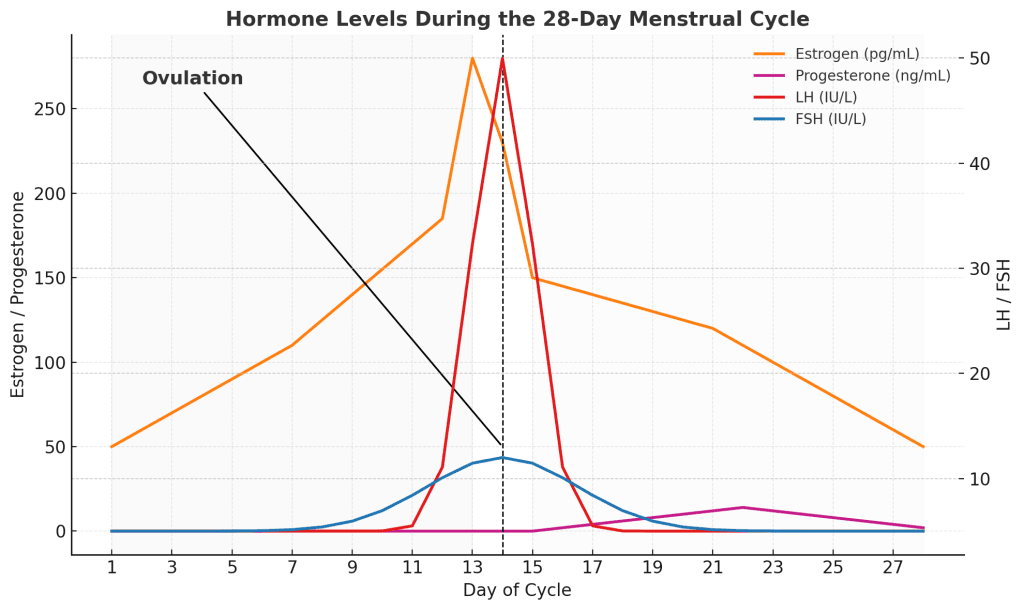Enter your last period and cycle length to see your fertile window and likely ovulation day on a simple calendar—plus daily pregnancy odds.
Phase:
How to Use Our Ovulation Calculator
Getting your personalized fertility calendar is simple. Here’s a quick guide to understanding all of its features.
Step 1: Enter Your Cycle Details
To get started, enter the first day of your last menstrual period and your average cycle length, then click the “Calculate” button. You’ll instantly see a detailed, color-coded calendar of your entire cycle, including:
- Your Estimated Fertile Window (the days you’re most likely to conceive)
- Your Approximate Ovulation Day (when your egg is likely released)
- Your Highest Conception Chance Day
- Your Next Period Starting Date
- Your Estimated Pregnancy Chance for each specific day

Step 2: Explore Your Calendar
Our calendar is fully interactive. You can tap or click on any date to see more details about that day’s phase—whether it’s the “Follicular Phase,” “Luteal Phase,” “Fertile Window,” or “Highest Chance.” The calendar below your results updates dynamically as you enter or adjust your information, and you can navigate to future or past months using the arrow buttons.
Understanding Your Results: The Science Behind Your Fertile Window
Your menstrual cycle is a complex symphony of hormones, but the timing of ovulation is surprisingly predictable. Our calculator is built on decades of scientific research to give you a clear and accurate picture of your fertility. Here’s what the key dates in your results mean.
- The Fertile Window: You can only conceive during a roughly six-day period each cycle. This “fertile window” includes the day of ovulation and the five days leading up to it. This is because sperm can survive in the female reproductive tract for up to five days, waiting for an egg to be released.
- Ovulation Day: This is the day your ovary releases a mature egg. The egg is only viable for about 12-24 hours after release, which is why having sperm already present is key to conception. Our calculator estimates this day by counting back 14 days from the start of your next expected period, a method used by healthcare professionals.
- Peak Fertility (Highest Chance Day): While the entire fertile window offers a chance of pregnancy, clinical research shows that the 2-3 days immediately before and including ovulation have the highest probability of conception. Our calendar highlights the single day with the peak statistical chance to help you focus your efforts.
The Hormonal Cascade That Governs Your Cycle
The dates on the calendar are all driven by a predictable rise and fall of key hormones throughout your cycle, as illustrated in the chart below. The most critical event is the Luteinizing Hormone (LH) surge, which acts as the final trigger for the ovary to release the egg, initiating ovulation about 24-36 hours later.

This is why our tool doesn’t just show you dates—it estimates how your odds shift day by day, giving you a powerful insight into your body’s natural rhythms.
Frequently Asked Questions
It provides an average-based estimate from your last few cycles, but day-to-day hormones can still shift. Pair the calculator with LH test strips or basal-temperature tracking for higher accuracy.
The calculator projects fertile days from past cycle length, while kits measure the real-time LH surge that triggers ovulation. Use both for a forecast and a same-day confirmation.
Yes—an optimal luteal phase is 11–14 days. Shorter phases can hinder implantation. If yours is consistently under 10 days, consider seeing a fertility specialist.
Breastfeeding hormones can delay or suppress ovulation, making cycle length unpredictable. Use the calculator only after at least three regular periods have returned.
Most users regain normal cycles within 1–3 months. Start tracking once you’ve logged two consistent cycle lengths; predictions sharpen as more data is added.
Occasionally, yes—light “silent” periods or very long cycles can hide ovulation. Tracking cervical mucus or LH can reveal fertile days even when bleeding is irregular.
The fertile window spans the 5 days before ovulation plus the ovulation day itself—when sperm and egg can meet. Ovulation is a 12–24 h event inside that window.
Most reliable results come 14 days after ovulation (around your expected period). Early tests at 9–11 DPO can pick up strong hCG levels but carry a higher false-negative rate.
For many women, ovulation happens about 12 to 16 days before the next period. That means you can typically get pregnant starting around day 8 to day 19 of your cycle, counting from the first day of your period. But the exact days vary depending on your cycle length and regularity. For a more personalized answer, try our Ovulation Calculator. It shows an estimate of your percent pregnancy chance per day.
Medical Disclaimer
Our Ovulation Calculator uses data derived from peer-reviewed research and established clinical methods to provide personalized fertility estimates. However, it is intended for informational purposes only and is not a substitute for professional medical advice, diagnosis, or treatment. If you have concerns about your fertility or overall health, please consult a healthcare provider.
